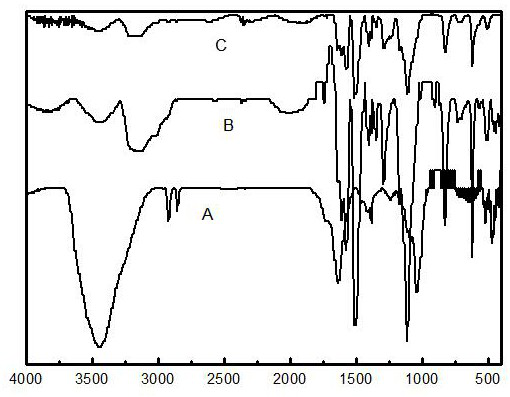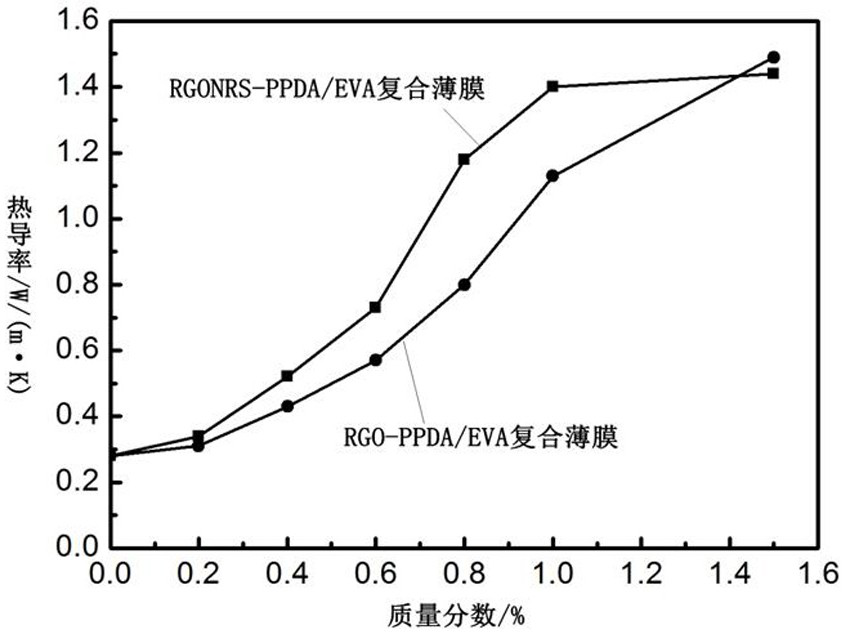Preparation method of graphene nanobelt-poly-p-phenylenediamine/eva composite film
A technology of graphene nanobelts and poly-p-phenylenediamine, applied in chemical instruments and methods, heat exchange materials, etc., can solve the problems of accelerating the aging rate of EVA films, depositing at the bottom of toluene, and decreasing mechanical properties, achieving Scientific and reasonable preparation method, excellent mechanical properties, and the effect of improving compatibility
- Summary
- Abstract
- Description
- Claims
- Application Information
AI Technical Summary
Problems solved by technology
Method used
Image
Examples
preparation example Construction
[0027] A preparation method of reduced graphene oxide nanobelt-poly-p-phenylenediamine / EVA composite film, the specific steps are as follows:
[0028] 1) After cold treatment of multi-walled carbon nanotubes (MWCNTS), place them in a low-temperature reaction bath, slowly add concentrated sulfuric acid while stirring, and add potassium permanganate in batches within 3 hours, and control the reaction temperature below 4°C After 0.5h, reheat to 50°C, continue to react for 12h, then add deionized water, stir for 15min, and dropwise add 30% hydrogen peroxide, wash with acid and water until neutral, and freeze-dry to obtain ribbon-shaped graphene oxide nano bring;
[0029] 2) Ultrasonic disperse graphene oxide nanoribbons in deionized water, add p-phenylenediamine monomer and ammonium persulfate initiator in a low-temperature reaction bath, perform low-temperature polymerization reaction below 4°C for 24 hours, then stand for 2 hours, and use deionized Wash with water and absolute ...
Embodiment 1
[0036] 1) Prepare graphene oxide nanoribbons by improving the Hummers method: first cold-treat 1 g of carbon nanotubes, slowly add 45 mL of 98% concentrated sulfuric acid and 5 mL of concentrated phosphoric acid into a low-temperature reaction bath, stir and mix well, and dissolve 7 g of high Add potassium manganate to the mixed acid in batches, then react at low temperature for half an hour, move the reaction system to a water bath and heat to 50°C, continue the reaction for 12 hours, then add 1000mL deionized water to obtain a gray-black graphene oxide nanoribbon suspension, continue After stirring for 15 minutes, 30% hydrogen peroxide was added dropwise to obtain a graphene oxide nanoribbon release solution, and finally pickled with 3% hydrochloric acid solution, then washed to neutrality to obtain a graphene oxide nanoribbon gel, and the graphene oxide nanoribbon gel was obtained. The gel was lyophilized to obtain a fluffy graphene oxide nanoribbon (GONRS) solid;
[0037] ...
Embodiment 2
[0042] In step 4), 0.030g RGONRS-PPDA nanopowder was added, and other condition parameters were the same as in Example 1, and finally a 0.4wt% RGONRS-PPDA / EVA composite film was obtained.
PUM
 Login to View More
Login to View More Abstract
Description
Claims
Application Information
 Login to View More
Login to View More - R&D
- Intellectual Property
- Life Sciences
- Materials
- Tech Scout
- Unparalleled Data Quality
- Higher Quality Content
- 60% Fewer Hallucinations
Browse by: Latest US Patents, China's latest patents, Technical Efficacy Thesaurus, Application Domain, Technology Topic, Popular Technical Reports.
© 2025 PatSnap. All rights reserved.Legal|Privacy policy|Modern Slavery Act Transparency Statement|Sitemap|About US| Contact US: help@patsnap.com



